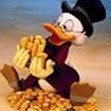....padrao de um fundo........
8 mensagens
|Página 1 de 1
topos
um amigo meu desaparecido ha uns tempos dos foruns procurou descobrir um padrao para os fundos......a ideia seria detectar com o maior grau de certeza um provavel fundo...alias.....o sonho de qualquer trader que se preze.. ele encontrou uma.
Espero que tb tenha encontrado um padrão para detectar topos...
Assim fica com os primórdios de um sistema de se lhe tirar o chapéu!
"Don't try to buy at the bottom and sell at the top. It can't be done except by liars." - Bernard Baruch
Anonymous Escreveu:Um erro a que pode conduzir a analise tecnica:
Encontrar padroes repetitivos nos gráficos.
Não é um erro, é uma das coisas a que a AT se propõe.
O que acabou de dizer é o mesmo que dizer: «um erro a que conduz a medicina, encontrar sintomas que possam identificar doenças».
Como é óbvio, em si, não é um erro.
Anonymous Escreveu:Não acham que se isso fosse assim os mercados seriam facilmente previsiveis? isso talvez funcionasse no passado, quando era uma minoria a olhar e procurar sinais nos gráficos.
Mas caro visitante, os Analistas Técnicos são uma minoria. Eram e ainda são. Quantos, neste universo de milhões de investidores, são realmente investidores que investem com base na análise técnica.
Vá por aí fora falar com investidores e rapidamente constatará que a esmagadora maioría nem sabe o que é a AT e muitos dos que sabem, não a utilizam de facto, acabando por se guiar por palpites, emoções, notícias, rumores e pela informação em geral que lhe chega.
Antes de tomar contacto com os foruns/sites de bolsa tinha ouvido falar alguma vez de AT?
Duvido...
Relativamente aos padrões, os padrões são apenas uma parte da AT, uma das leituras/observações que se podem extrair dos gráficos.
O que não é existe é um padrão de inversão, existem diversos padrões, nem sempre facilmente identificaveis, e mesmo inversões que não obedecem a qualquer padrão específico.
O que não deixa de ser surpreendente é que mercado, ao longo dos anos, repita comportamentos tipificados que produzem padrões nos gráficos. Algumas experiencias interessantes consistem em reproduzir mercados artificiais e testar o comportamento de uma massa de investidores em determinadas condições e verificar que a massa reage, regra geral, segundo comportamentos tipificados.
É isso que conduz aos padrões. A esmagadora maioría dos investidores nem sequer se apercebe do que está a acontecer ou pensa sequer em analisar a informação dessa forma.
Uma pequena minoría investe com base (apenas) nesses prossupostos e outra pequena minoría cruza essa informação com outra informação (fundamental ou outra).
O que não se pode pedir é que a AT seja fácil (nenhum método de análise é fácil ou evidente) e que todos os investidores a consigam usar de forma eficiente. Até porque análise é apenas parte do trading e não o todo...
FLOP - Fundamental Laws Of Profit
1. Mais vale perder um ganho que ganhar uma perda, a menos que se cumpra a Segunda Lei.
2. A expectativa de ganho deve superar a expectativa de perda, onde a expectativa mede a
__.amplitude média do ganho/perda contra a respectiva probabilidade.
3. A Primeira Lei não é mesmo necessária mas com Três Leis isto fica definitivamente mais giro.
Gosto muito deste texto.
Encyclopedia
of
Chart Patterns
Thomas N. Bulkowski
Jim is struggling.
He is the owner of JCB Superstores and his competitor across town is
beating him up; there is blood all over Jim's ledger. He decides it is time to take
off the gloves: JCB goes public. He uses the money from the initial public
offering to buy his competitor and add a few more stores around town.
With a growing sales base, Jim's clout allows him to negotiate lower
prices for the office supplies he is retailing. He passes on part of the savings to
his customers, while watching his margins widen, and plows the profits back
into building more stores.
Jim calls his friend, Tom, and tells him of his plans to expand the operation
statewide. They chat for a while and exchange business tactics on how best
to manage the expansion. When Tom gets off the phone, he decides to conduct
his own research on JCB. He visits several stores and sees the same thing:
packed parking lots, people bustling around with full shopping carts, and lines
at the checkout counters. He questions a few customers to get a sense of the
demographics. At a few stores, he even chats with suppliers as they unload their
wares. Back at the office, he does a thorough analysis of the financials and
looks at the competition. Everything checks out so he orders his trading partners
to buy the stock at no higher than 10.
When news of the expansion plan hits the wires, the Street panics. It is,
after all, a soft economy and expanding willy-nilly when a recession looms is
daft, maybe even criminal, according to them. The stock drops below 10 and
Tom's crew makes its move. They quietly buy as much as they can without
raising suspicion. The stock rises anyway. It goes back up to 11, then 12, and
rounds over at 13 before heading back down. Several months go by and the economic outlook is as bleak as ever. The
stock eases down to 9. After Tom checks in with Jim for the latest public news,
Tom's team buys more. It is an easy score because investors are willing to
dump the stock especially as year-end tax selling approaches.
Six weeks later the company releases the sales numbers for JCB; they are
better than expected. The stock rises 15% in minutes and closes at 10%. And
that is just for starters. Six months later, it's clear the economy was never
in danger of entering a recession and everyone sees boom times ahead. The
stock hits 20.
Years go by, the stock splits a few times, and the holiday season looms.
Tom interviews a handful of customers leaving JCB Superstores and discovers
that they are all complaining about the same thing: The advertised goods are
missing. Tom investigates further and discovers a massive distribution problem,
right at the height of the selling season. JCB has overextended itself;
the infrastructure is simply not there to support the addition of one new store
each week.
Tom realizes it is time to sell. He tells his trading department to dump
the stock immediately but for no less than 2814. They liquidate about a third of
their large holdings before driving the stock down below the minimum.
Since it is the holidays, everyone seems to be in a buying mood. Novice
investors jump in at what they consider a bargain price. The major brokerage
houses climb aboard and tout the stock, but Tom knows better. When the
stock recovers to its old high, his trading partners sell the remainder of their
holdings. The stock tops out and rounds over. During the next month and a
half, the stock drifts down, slowly, casually. There does not appear to be a rush
for the exits—just a slow trickle as the smart money quietly folds up shop.
Then news of poor holiday sales leaks out. There is a rumor about distribution
problems, merchandising mistakes, and cash flow problems. Brokerage
firms that only weeks before were touting the stock now advise their clients to
sell. The stock plummets 39% overnight.
One or two analysts say the stock is oversold; it is a bargain and investors
should add to their positions. Many bottom fishers follow their brokers' recommendation
and buy the stock. Big mistake. The buying enthusiasm pushes
the price up briefly before a new round of selling takes hold. Each day the stock
drops a bit lower, nibbling away like waves washing against a castle of sand. In
2 months' time, the stock is down another 30%.
The following quarter JCB Superstores announces that earnings will
likely come in well below consensus estimates. The stock drops another 15%.
The company is trying to correct the distribution problem, but it is not something
easily fixed. They decide to stop expanding and to concentrate on the
profitability of their existing store base.
Two years later, Tom pulls up the stock chart. The dog has been flat for
so long it looks as if its heartbeat has stopped. He calls Jim and chats about the
outlook for JCB Superstores. Jim gushes enthusiastically about a new retailing
concept called the Internet. He is excited about the opportunity to sell office
supplies on-line without the need for bricks and mortar. There is some risk
because the on-line community is in its infancy, but Jim predicts it will quickly
expand. Tom is impressed, so he starts doing his homework and is soon buying
the stock again.
Investment Footprints
If you picture in your mind the price action of JCB Superstores, you should
recognize three chart patterns: a double bottom, a double top, and a dead-cat
bounce. To knowledgeable investors, chart patterns are not squiggles on a
price chart; they are the footprints of the smart money. The footprints are all
they need to follow as they line their pockets with greater and greater riches.
To others, such as Tom, it is hard work and pavement pounding before they
dare take a position in a stock. They are the ones making the footprints. They
are the smart money that is setting the rules of the game—a game anyone can
play. It is called investing.
Whether you choose to use technical analysis or fundamental analysis in
your trading decisions, it pays to know what the market is thinking. It pays to
look for the footprints. Those footprints may well steer you away from a cliff
and get you out of a stock just in time. The feet that make those footprints are
the same ones that will kick you in the pants, waking you up to a promising
investment opportunity.
This book gives you the tools to spot the footprints, where they predict
the stock is heading, how far it will travel, and how reliable the trail you are following
really is. The tools will not make you rich; tools rarely do. But they are
instruments to greater wealth. Use them wisely.
Encyclopedia
of
Chart Patterns
Thomas N. Bulkowski
Jim is struggling.
He is the owner of JCB Superstores and his competitor across town is
beating him up; there is blood all over Jim's ledger. He decides it is time to take
off the gloves: JCB goes public. He uses the money from the initial public
offering to buy his competitor and add a few more stores around town.
With a growing sales base, Jim's clout allows him to negotiate lower
prices for the office supplies he is retailing. He passes on part of the savings to
his customers, while watching his margins widen, and plows the profits back
into building more stores.
Jim calls his friend, Tom, and tells him of his plans to expand the operation
statewide. They chat for a while and exchange business tactics on how best
to manage the expansion. When Tom gets off the phone, he decides to conduct
his own research on JCB. He visits several stores and sees the same thing:
packed parking lots, people bustling around with full shopping carts, and lines
at the checkout counters. He questions a few customers to get a sense of the
demographics. At a few stores, he even chats with suppliers as they unload their
wares. Back at the office, he does a thorough analysis of the financials and
looks at the competition. Everything checks out so he orders his trading partners
to buy the stock at no higher than 10.
When news of the expansion plan hits the wires, the Street panics. It is,
after all, a soft economy and expanding willy-nilly when a recession looms is
daft, maybe even criminal, according to them. The stock drops below 10 and
Tom's crew makes its move. They quietly buy as much as they can without
raising suspicion. The stock rises anyway. It goes back up to 11, then 12, and
rounds over at 13 before heading back down. Several months go by and the economic outlook is as bleak as ever. The
stock eases down to 9. After Tom checks in with Jim for the latest public news,
Tom's team buys more. It is an easy score because investors are willing to
dump the stock especially as year-end tax selling approaches.
Six weeks later the company releases the sales numbers for JCB; they are
better than expected. The stock rises 15% in minutes and closes at 10%. And
that is just for starters. Six months later, it's clear the economy was never
in danger of entering a recession and everyone sees boom times ahead. The
stock hits 20.
Years go by, the stock splits a few times, and the holiday season looms.
Tom interviews a handful of customers leaving JCB Superstores and discovers
that they are all complaining about the same thing: The advertised goods are
missing. Tom investigates further and discovers a massive distribution problem,
right at the height of the selling season. JCB has overextended itself;
the infrastructure is simply not there to support the addition of one new store
each week.
Tom realizes it is time to sell. He tells his trading department to dump
the stock immediately but for no less than 2814. They liquidate about a third of
their large holdings before driving the stock down below the minimum.
Since it is the holidays, everyone seems to be in a buying mood. Novice
investors jump in at what they consider a bargain price. The major brokerage
houses climb aboard and tout the stock, but Tom knows better. When the
stock recovers to its old high, his trading partners sell the remainder of their
holdings. The stock tops out and rounds over. During the next month and a
half, the stock drifts down, slowly, casually. There does not appear to be a rush
for the exits—just a slow trickle as the smart money quietly folds up shop.
Then news of poor holiday sales leaks out. There is a rumor about distribution
problems, merchandising mistakes, and cash flow problems. Brokerage
firms that only weeks before were touting the stock now advise their clients to
sell. The stock plummets 39% overnight.
One or two analysts say the stock is oversold; it is a bargain and investors
should add to their positions. Many bottom fishers follow their brokers' recommendation
and buy the stock. Big mistake. The buying enthusiasm pushes
the price up briefly before a new round of selling takes hold. Each day the stock
drops a bit lower, nibbling away like waves washing against a castle of sand. In
2 months' time, the stock is down another 30%.
The following quarter JCB Superstores announces that earnings will
likely come in well below consensus estimates. The stock drops another 15%.
The company is trying to correct the distribution problem, but it is not something
easily fixed. They decide to stop expanding and to concentrate on the
profitability of their existing store base.
Two years later, Tom pulls up the stock chart. The dog has been flat for
so long it looks as if its heartbeat has stopped. He calls Jim and chats about the
outlook for JCB Superstores. Jim gushes enthusiastically about a new retailing
concept called the Internet. He is excited about the opportunity to sell office
supplies on-line without the need for bricks and mortar. There is some risk
because the on-line community is in its infancy, but Jim predicts it will quickly
expand. Tom is impressed, so he starts doing his homework and is soon buying
the stock again.
Investment Footprints
If you picture in your mind the price action of JCB Superstores, you should
recognize three chart patterns: a double bottom, a double top, and a dead-cat
bounce. To knowledgeable investors, chart patterns are not squiggles on a
price chart; they are the footprints of the smart money. The footprints are all
they need to follow as they line their pockets with greater and greater riches.
To others, such as Tom, it is hard work and pavement pounding before they
dare take a position in a stock. They are the ones making the footprints. They
are the smart money that is setting the rules of the game—a game anyone can
play. It is called investing.
Whether you choose to use technical analysis or fundamental analysis in
your trading decisions, it pays to know what the market is thinking. It pays to
look for the footprints. Those footprints may well steer you away from a cliff
and get you out of a stock just in time. The feet that make those footprints are
the same ones that will kick you in the pants, waking you up to a promising
investment opportunity.
This book gives you the tools to spot the footprints, where they predict
the stock is heading, how far it will travel, and how reliable the trail you are following
really is. The tools will not make you rich; tools rarely do. But they are
instruments to greater wealth. Use them wisely.
- Mensagens: 232
- Registado: 2/1/2004 22:29
post...nao concordo...
o ultimo visitante sou eu.....falha de log in
- Mensagens: 39
- Registado: 24/3/2004 19:45
..nao concordo....
e uma mera questão estatistica e de probabilidades...quantas mais tiverem do nosso lado melhor.......e um padrao é bom quando a probabilidade de se verificar for mais alta....ou melhor....quando detectado a tempo ...permite prever com grande grau de probabilidade os momentos futuros...........estatisticas e probabilidades..logo nunca certezas.....basta haver 1 hipotese em n milhoes...que essa hipoete e possivel...mas quanto maior a probabilidade.......melhor........
-
Visitante
...
Bom dia,
Não sei se tenho muito para ajudar neste tema...
E decerteza que o Marco António tem já uma panóplia de situações preparadas para "postar" a qualquer momento...


No entanto, para fundos, de "bottom" e não dos outros.. gosto especialmente de:
gosto especialmente de:
 Fundo em V (quanto mais acentuado melhor)
Fundo em V (quanto mais acentuado melhor)
 Duplo fundo
Duplo fundo
SirPatrick
Não sei se tenho muito para ajudar neste tema...
E decerteza que o Marco António tem já uma panóplia de situações preparadas para "postar" a qualquer momento...
No entanto, para fundos, de "bottom" e não dos outros..
SirPatrick
- Mensagens: 869
- Registado: 6/11/2002 16:28
- Localização: Avr
....padrao de um fundo........
um amigo meu desaparecido ha uns tempos dos foruns procurou descobrir um padrao para os fundos......a ideia seria detectar com o maior grau de certeza um provavel fundo...alias.....o sonho de qualquer trader que se preze.. ele encontrou uma.....esse padrao seria composto de 5 barras.......em que duas seriam de confirmaçao...alguem alguma vez fez alguma tentativa?
- Mensagens: 39
- Registado: 24/3/2004 19:45
8 mensagens
|Página 1 de 1
Quem está ligado:
Utilizadores a ver este Fórum: aaugustob69, Bar38, darkreflection, Gioes, Google [Bot], Google Adsense [Bot], m-m, malakas, Manchini888, Mr.Warrior, navaldoc, OCTAMA, Rolling_Trader e 216 visitantes



